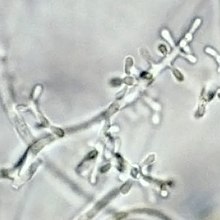Trichophyton rubrum
| Trichophyton rubrum | |
|---|---|
 |
|
| Microconidia of T. rubrum | |
| Scientific classification | |
| Kingdom: | Fungi |
| Phylum: | Ascomycota |
| Subphylum: | Pezizomycotina |
| Class: | Eurotiomycetes |
| Order: | Onygenales |
| Family: | Arthrodermataceae |
| Genus: | Trichophyton |
| Species: | T. rubrum |
| Binomial name | |
|
Trichophyton rubrum (Castell.) Sabour. |
|
| Synonyms | |
|
|
Trichophyton rubrum is a dermatophytic fungus in the phylum Ascomycota, class Euascomycetes. It is an exclusively clonal,anthropophilic saprotroph that colonizes the upper layers of dead skin, and is the most common cause of athlete's foot, fungal infection of nail, jock itch, and ringworm worldwide.Trichophyton rubrum was first described by Malmsten in 1845 and is currently considered to be a complex of species that comprises multiple, geographically patterned morphotypes, several of which have been formally described as distinct taxa, including T. raubitschekii, T. gourvilii, T. megninii and T. soudanense.
Typical isolates of T. rubrum are white and cottony on the surface. The colony underside is usually red, although some isolates appear more yellowish and others more brownish.Trichophyton rubrum grows slowly in culture with sparse production of teardrop or peg-shaped microconidia laterally on fertile hyphae. Macroconidia, when present, are smooth-walled and narrowly club-shaped, although most isolates lack macroconidia. Growth is inhibited in the presence of certain sulfur-, nitrogen- and phosphorus-containing compounds. Isolates of T. rubrum are known to produce penicillin in vitro and in vivo.
Strains of T. rubrum form two distinct biogeographical subpopulations. One is largely restricted to parts of Africa and southern Asia, while the other consists of a population that has spread around the world. Isolates of the Afro-Asiatic subpopulation most commonly manifest clinically as tinea corporis and tinea capitis. In contrast, the globally-distributed subpopulation manifests predominantly in tinea pedis and tinea unguium. Different members of the T. rubrum complex are endemic to different regions; isolates previously referred to T. megninii originate from Portugal, while T. soudanense and T. gourvilii are found in Sub-Saharan Africa. All species included in the T. rubrum complex are "–" mating type with the exception of T. megninii which represents the "+" mating type and is auxotrophic for L-histidine. The mating type identity of T. soudanense remains unknown.Trichophyton raubitschekii, which is common from northwestern India and southeast Asia as well as parts of West Africa, is characterized by strongly granular colonies and is the only variant in the complex that reliably produces urease.
...
Wikipedia
